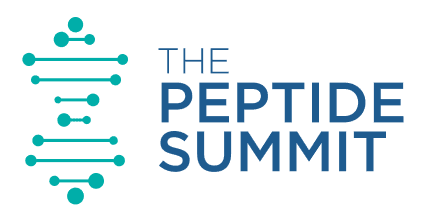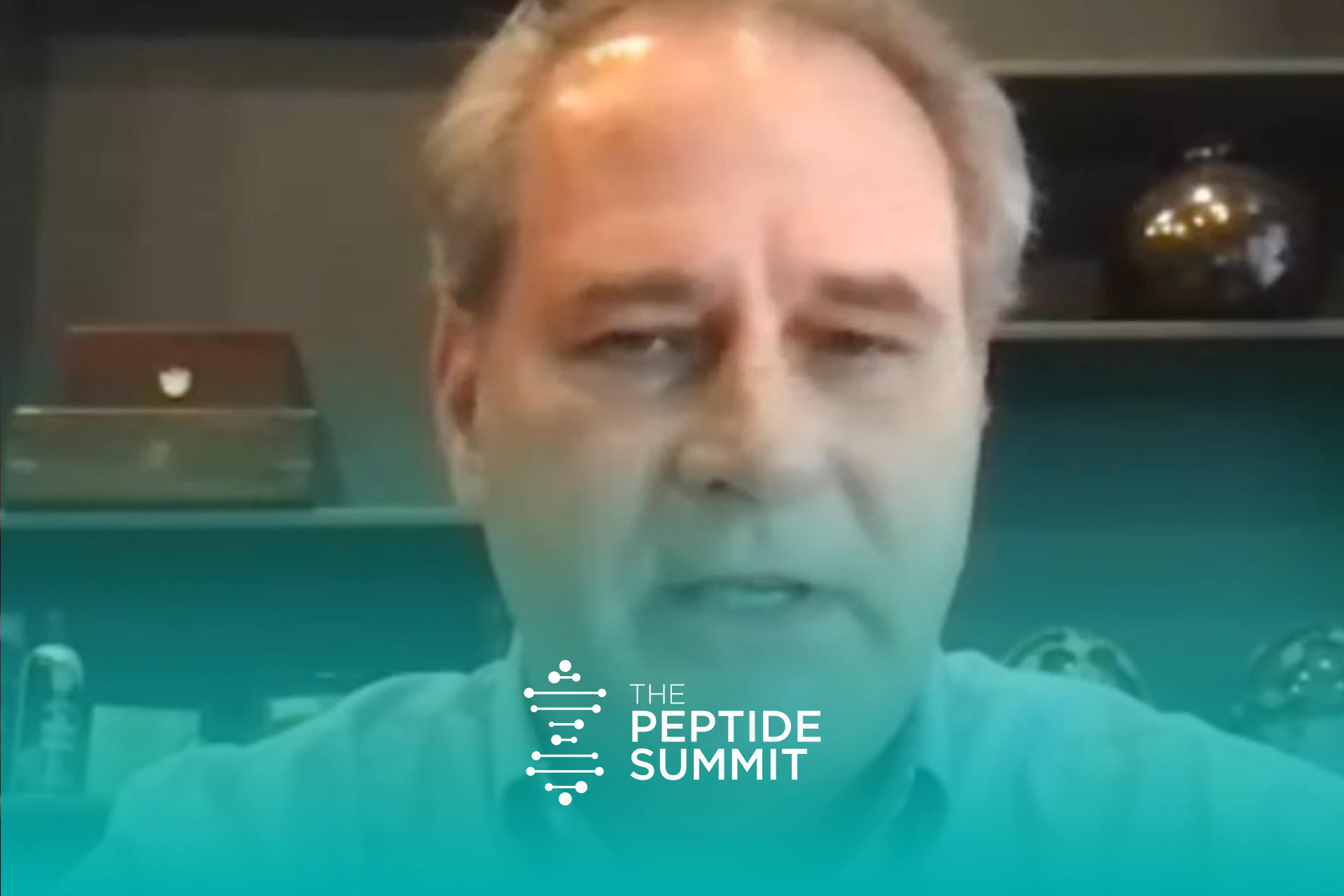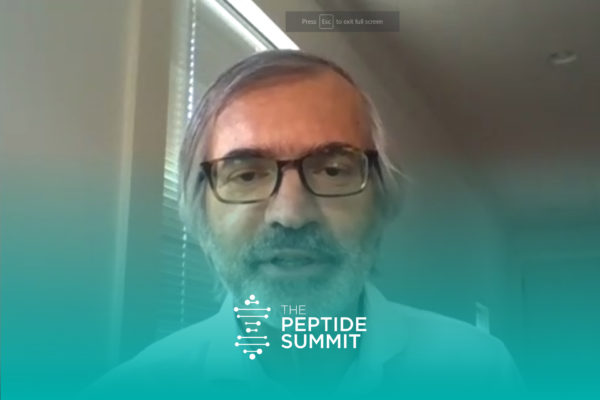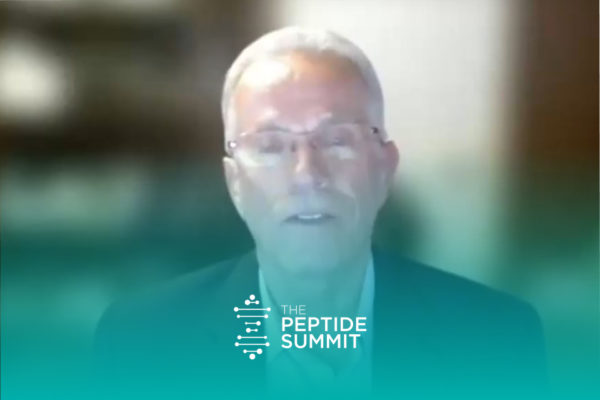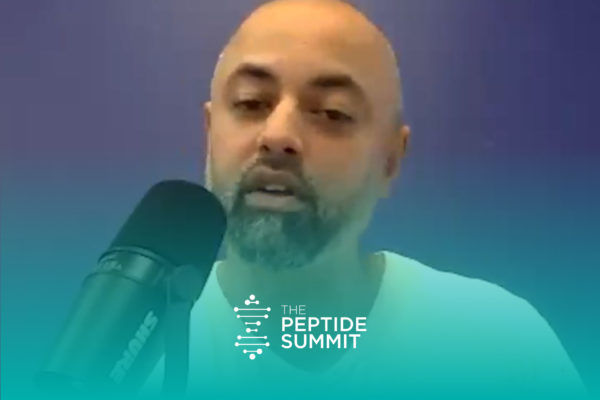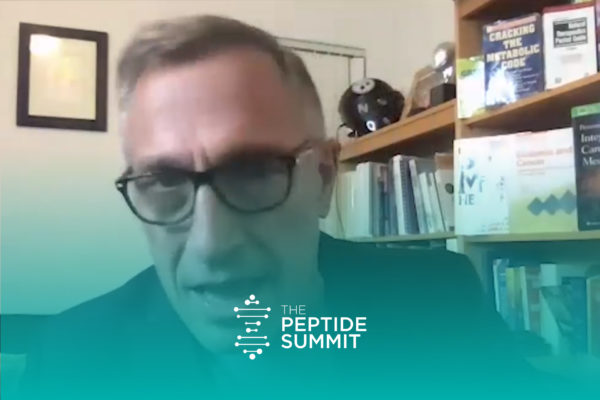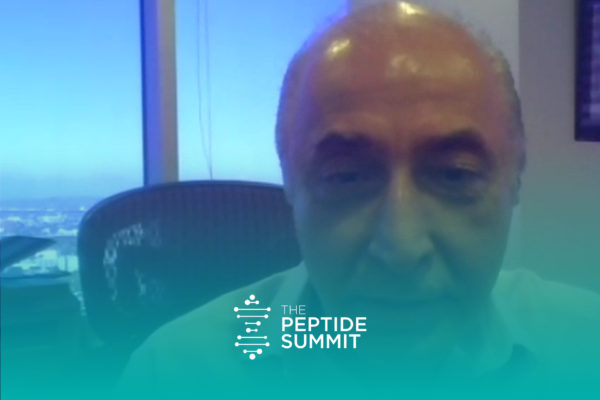Join the discussion below

Kent Holtorf, MD is the medical director of the Holtorf Medical Group (www.HoltorfMed.com) and the founder and medical director of the non-profit National Academy of Hypothyroidism (NAH) (www.NAHypothyroidism.org), which is dedicated to the dissemination of new information to doctors and patients on the diagnosis and treatment of hypothyroidism. He is... Read More

Jim Prather has been working as a President at WAVi for 7 years. WAVi is part of the Manufacturing industry, and located in Colorado, United States. Read More
- How to use the WaVi to track brain trauma and recovery
- What sports injuries can teach us about Alzheimers and dementia
- The #1 peptide to prevent (and minimize) brain trauma from injury and aging
Related Topics
Aging Brain, Athletic Injuries, Baseline Scan, Behavioral Issues, Brain Activity, Brain Care, Brain Damage, Brain Health, Brain Power, Brain Waves, Chronic Traumatic Encephalopathy Cte, Concussions, Dementia, Electroencephalogram Eeg, Head Trauma, Memory Loss, Neurological Disorders, Objective Measurements, Peptides, Return To PlayKent Holtorf, M.D.
Hello, it’s Dr. Kent Holtorf with another episode of The Peptide Summit. Today we have a great interview for me. Jim Prather is going to be talking about objective measures of brain function for health and performance. Thanks for coming on Jim.
Jim Prather
You’re welcome. Thanks for having me.
Kent Holtorf, M.D.
Yeah, and so I’ve been looking for a device, seem to be talking about the WAVi and we’ll get into that. It measures essentially your brain function and looking for a number of years at conferences. “Hey, we need to get this,” and it evaluating of different systems, and not that I really liked, and I kept hearing good things about WAVi, but I had never seen them. Then, a good friend of mine, a doctor, said, “Oh, we’re using it. Oh, my God. This thing is great,” and so they came and actually did a demo the other day. I hadn’t slept and so my brain was not as … It was a little disappointed, but it shows how sleep is so important. Really looking forward to incorporating it in our practice. We generally treat very sick patients who have tons of cognitive disfunction and almost dementia. Looking forward to seeing how that is and also showing improvement, and then also bringing in the healthy patients that maybe they have Alzheimer’s in their family and they’re worried. And you can make a difference.
When you see before and after, and they have beautiful color. Basically their whole software that will analyze all this complex, you just see all these brain waves everywhere. They make it very understandable. Very, I think, compelling for the patient, where you show, “Hey, your brain is not where it should be,” and then you can get them better. They’re fricking happy with you and they’re going to tell people about it. This quick little bio on Jim, he brings over 30 years of executive and financial experience, from the information technology, media, and consumer electronics industry to the WAVi team. From the beginning of WAVi in one of the original investors, he’s now in the role of president of WAVi Medical and CFO.
He’s been working with doctors and researchers to ensure that the WAVi hardware and software is effective and practical in improving patient outcomes. His work involves identifying individuals in groups interested in the brain journey from athletes, including US Olympians, to leading brain researchers, cardiologists, concussion experts, I just interviewed last night, but forgot to hit “record.” Integrative health practitioners, bio hackers. I think this is just a great device for almost every field because we don’t have a measure of brain “before” and “after.” And it’s the brain. It controls everything. His deep understanding and a need to work collaboratively across the brain ecosystem provides these diverse groups the ability to change the face of brain care. I think the field, medicine, is changing. Really focusing on the brain. You think they would have focused on the brain years, decades ago, but it seems like they’re finally getting around to it.
Jim Prather
I agree with that. It’s pretty interesting. It’s evolving and I think even with people locked down and depression, anxiety, and post-COVID type stuff coming up, “brain fog” is now actually a term everybody’s using. A lot of different things that are bringing it to light. It’s pretty exciting.
Kent Holtorf, M.D.
Yeah. I mean, everyone has brain issues. Everyone from the athlete that has multiple concussions and even you look at all these sports where, you don’t think that many, like soccer or even people who skateboard. It’s just that chronic … You don’t even have to have a big auto accident, and other issues, but nice thing is, there’s ways to improve it. You can show them before and after. This is a random question, but would you let your kid play football?
Jim Prather
Well, I’m in Texas, so it’s a national frame line here. I probably would. I might keep him in flag football until he’s in his middle school and then I would definitely monitor his brain health. We utilize WAVi as part of a base lining routine with a number of sports, including stuff that I had no clue had so many concussions. Like women’s volleyball. I mean, that’s huge. Cheerleading is one of the worst ones. You look through it and say, “There’s no reason why anybody shouldn’t just have or avail themselves of a base line scan for their kids or for their student athletes.
Kent Holtorf, M.D.
Oh, you know what? I’m just thinking. I didn’t think about that. Are any professional football teams using this?
Jim Prather
The professionals are interesting because there are some conflicts obviously in-
Kent Holtorf, M.D.
Yeah. They don’t want to really know.
Jim Prather
Yeah. We are starting to work with retired NFL players, which is exciting, and they do want to know at that point. They want to understand the damage done and what they can do about it. We’re obviously just a measurement device. We’re agnostic from the interventions that doctors do, but it gives a great way, as you said, a pre-post measurement on interventions.
Kent Holtorf, M.D.
Yeah. I mean, you need to know because it’s not very powerful, aw, the person says they can think better. How do you put that in a research study?
Jim Prather
Right, and we get that all the time. “Well, what are you going to see? I don’t know if I have a brain.” It’s not a measurement of intelligence. It’s a measurement of brain activity. Of brain power. Of brain speed. Those are the measurements we do using an electroencephalogram. An EEG. We just made it easier to do it and then we’ve taken all that very complex data and made those measurements easy to understand for doctors of all sorts, and clinicians too.
Kent Holtorf, M.D.
Yeah. In fact, we’ve don’t have much time to do the demo, but he’s like, “Are you ADD and do you sleep?” Oh, my God, I’m the most ADD person I’ve ever met and I hadn’t slept. I slept three hours the night before and seven power points to do this week. I hit it right off the bat with just a brief scan.
Jim Prather
Yeah. It’s interesting you mentioned that. We started the company with this concept, and this is 13, 14 years ago, of how do you put objective measurements around the brain? The aging brain in particular. All of us have parents that are … Either you know someone or you’re one person removed from someone that’s dealing with dementia or pre-Alzheimer’s symptoms.
Kent Holtorf, M.D.
It’s devastating.
Jim Prather
Oh, it’s brutal. Especially on the caregivers, but if there’s a way that you could track that. If there’s a way that you could see normal digression or if all of a sudden it seems to fall off a cliff, it’s something you need to do something about. But those measurements are not necessarily easy to collect or easy to display or communicate. And that’s where we started the company. Let’s create measurements around that. Because we are based out of Boulder Colorado, and we’re tied into the University of Colorado, we got pulled into a really cool study related to concussion. Working four years with the football team and women’s soccer team there, we measure baseline and post season on every athlete, and then measured 24, 48 hours after a concussion, and then on the return to play. We saw amazing things related to that. The aging brain, the injured brain, those are two of the big areas that we feel like we’re a great measurement tool for doctors to utilize.
Kent Holtorf, M.D.
Wow. And when you see in an acute concussion, what? You generally see low voltage in that area?
Jim Prather
Correct. That’s absolutely right. In general, we had 100% correlation in our study with the combination of a drop in voltage and the reaction time measurement that we have. And those two together correlated 100% with what the docs were saying. The interesting thing was, it’s not so much getting the kid off the field. It’s more five days, 10 days later, it’s a very difficult-
Kent Holtorf, M.D.
When to put them back.
Jim Prather
That’s exactly right. Return to play, return to learn. By then, they might have performance back up to where they were beforehand, but what we saw in about 36% of the time is that their measurements, their measurements related to spring, speed, and voltage and these things we’re doing objectively had not come back to their baseline scores. And that’s scary.
Kent Holtorf, M.D.
And especially, I think, probably intelligent people can compensate so people don’t notice.
Jim Prather
That’s right. Or he can just game the system. “Put me back in coach.” There’s people that-
Kent Holtorf, M.D.
Yeah. “I feel fine.” Yeah, you don’t want to be wimpy, right?
Jim Prather
No, and it’s unfortunate, but we do know that the concussed brain, if it’s damaged again, it’s in general a much worse injury to the brain.
Kent Holtorf, M.D.
When you re-damage a damaged area-
Jim Prather
That’s not good.
Kent Holtorf, M.D.
… Significantly worse than …
Jim Prather
Yep. And CTE and all the discussions of that we find that the majority of those are happening, those types of brains are happening with the people that are, the repetitive damage. A lot of times it’s not even noticed.
Kent Holtorf, M.D.
Can you explain CTE for everyone?
Jim Prather
Yeah. We all know what a concussion is. You get hit, whether it’s a car accident, a skateboard accident or football or whatever the sport or activity. And there’s usually a shearing of the brain because it’s this nice jello type thing inside of the skull that it shifts around. It’s built that way, and it’s built to take some hits, but not the big ones. That shearing occurs. That’s generally has issues with the brain and the functioning of it after that, and that’s generally a concussion. Now, I’m saying “general” because there are all sorts, and I’m not a doctor. I’m not going to claim to be one, but we know that those are the types of issues that happen. If it happens repetitively, over periods of time in a lifetime of sports, then that is what is generally, again, causes the damage that’s related to these players or more in the old days, the boxers. It was especially with boxers because they were getting hit all the time.
Kent Holtorf, M.D.
Punch drunk or whatever you used to call it, yeah.
Jim Prather
Exactly right, and that’s generally what was causing the CTE later on. There’s a lot of behavioral issues, loss of memory, damage. It’s devastating.
Kent Holtorf, M.D.
Rages, right? And things like that?
Jim Prather
Well, and imagine the frustration of that player, that ex-player that’s suffering through those. They’re used to be in performing at such a high level, and then all of a sudden you go from that great family of brotherhood or sisterhood on your team to nothing. You’ve got these depression issues. If you don’t keep working out the way you were, you’re going to have issues related to the physiology of your body, and there is just an impact on the brain because of all that.
Kent Holtorf, M.D.
Yeah, and I know a number of doctors that treat professional football player, professional athletes, and they’re telling me a number of them can’t find their way home. Even ones that are playing, they’re very impaired.
Jim Prather
Yeah.
Kent Holtorf, M.D.
And they’re still going.
Jim Prather
I think the issue there is there’s things that can be done still. Maybe not very, very late stage, but early stage or while they’re playing sports. There’s things that you can do to retain that plasticity of the brain and the ability to recreate and regenerate the cells there.
Kent Holtorf, M.D.
Yeah. I give lectures on, a lot of nutrients work, a lot of things work, but even with just the peptides, amazing studies on thiamycin beta 4, TB-4 frag actually because it gets in the blood-brain barrier. It’s much smaller, and BPC not only prevents damage, but it dramatically speeds the recovery back to normal. I think every football player should be on this stuff.
Jim Prather
Again, since we’re just a measurement device, the nice thing that we can do though in those situations is not just say, “Well, how do you feel?” “I feel great.” No, no, no. Here’s the measurement before. Here’s the measurement after. We’re seeing brain speed, brain voltage, reaction time. All these different measurements and markers improve. Your brain is better now. I can prove … And that is so helpful. Not just for the doctor, trying to figure out what’s the right mixture or concoction, but also for the patient to be able to say, “Well, dang. This is better. I am getting and moving in the right direction with this.”
Kent Holtorf, M.D.
Yeah. That’s what I was thinking when you guys came on. I’m like, “Okay, this is perfect. I want to start a number of studies and show the effects of we have what’s called the … Some brain peptides and even my stepsons, he was squirrely. He probably won’t watch this, and it’s like, “What’s wrong with him?” And we gave him this cerebral bath that’s like basically brain neural peptides and his brothers are like, “Oh, my God. He’s a new person. He’s so calm.” He’s bragging about his memory and saying people are commenting about his memory. How great it is. I’m like, “All I know is you’re much easier to deal with.”
Jim Prather
Wow. Very cool. That’s great and we are involved. It’s a research level device, so we’re involved in a lot of research. We’ve got a couple of NIH grant research projects. One around the study of pain. What does the brain look like that’s in pain? Another one-
Kent Holtorf, M.D.
Hey. I’ll have to do a bunch of studies. You guys fund any?
Jim Prather
Yeah. Actually, those are funded by the government which is really wonderful. They see the need for that. They’re looking for something that they can put into an emergency room to say, “Okay, that guy, he really don’t need those opioids. You’re just a lingerer.”
Kent Holtorf, M.D.
Just looking at the studies that have already been done, I can’t believe, with the peptides. That’s what everyone says when I give lectures. “How can you have hundreds of studies? I’ve never heard about it.”
Jim Prather
Yeah. A great question.
Kent Holtorf, M.D.
Well, what got you into the brain in particular? Or was it the sophistication of the software/hardware that really intracted you to this?
Jim Prather
I mean, first and foremost, as I said, my wife, her family has a history of Parkinson’s and has a grandmother that passed away with Alzheimer’s. My mother suffers from dementia. I’ve had four concussions. I did play football. I do know what that’s like or I should say I don’t remember, but people tell me about it.
Kent Holtorf, M.D.
People tell me.
Jim Prather
That’s right. I think on the injured and the ill brain, if you don’t have someone you’re directly related to, you’re probably just a step away from someone that is. It did interest us. When Dr. [Oakley 00:16:56] approached me, he’s my friend from college, and he said, “Hey, we’re going to start this company up. We helped fund up that original effort,” and then, like I said, six years ago he sucked me into his vortex and I’ve been working with him since to bring it out to public.
Kent Holtorf, M.D.
That’s good when we invest with a friend. I’ve never had to worry, because you don’t due diligence. It’s like, “Oh, okay.”
Jim Prather
Oh, no. We’ve had quite the time.
Kent Holtorf, M.D.
I would think, I don’t know. I’m trying to think of a study or whatever. I think they’re more scared of dementia than they are death.
Jim Prather
Correct. Well, they’re-
Kent Holtorf, M.D.
Which makes sense.
Jim Prather
… they’re definitely more scared of brain issues than heart issues now. Everybody thinks, “Well, I’ll just get a stent or I’ll get a valve replacement.” And like you said, there’s so much research, so much science around the heart and improving that. When it comes to the brain, I tell people it’s like deep space or the bottom of the ocean. It’s just a really very cool, very perplexing, very hard to understand organ of the body and it’s the most important one in the circle.
Kent Holtorf, M.D.
And you look at the medications we have. I mean, they maybe slow the rate of decline a little bit, but they’re just so basic compared to everything else. It’s crazy.
Jim Prather
I’m not going to judge on the pharmaceuticals out there. What I do know is that exercise and sleep and a community around you, things like those plus things that are natural, good diet, those things can help the brain immensely.
Kent Holtorf, M.D.
God, I hate that. I choose the pill that makes the body think it’s exercising, and thinks it’s fasting. But, this seems great from everyone from the integrative practitioner, I’m just picturing it in our practice, to so many different fields. What can the WAVi show people?
Jim Prather
Yeah. Great question. The key thing is understanding behind the scenes. It is an EEG device. It is doing what EEG’s have done for literally a hundred years. We’re collecting brainwaves. We’re assessing those. We do specific type of EEG called an evoked potential. We have headsets on. You’re going to hear a series of beeps. You’re going to react differently when you hear an odd tone and you’re clicking the mouse button than when you hear a common tone. Doo, doo, doo, doot. doo, doo, doo, doot. On that odd tone, your brain reacts differently. And we’re measuring, at the point, brain speed, voltage, and a physical reaction time. Again, this has been around since the ’60s. This is not new technology, its just not been packaged well.
Kent Holtorf, M.D.
And that’s where I find the best literature is old research that people haven’t paid attention to.
Jim Prather
Yep. And everybody knows about it, but we’ve done all these different new skins and what we needed to do, and what we did, is we went back and looked at the old stuff and said, “Well, wait a minute.” And not olden. It’s just a lot of research behind it and baked those algorithms. Put that quick artifacting in on the data to make sure it’s clean. The algorithms to make the data look useful and a nice report that a doctor could use. Even a report that can look very good for a customer or a patient that they could go through with them.
Kent Holtorf, M.D.
Yeah, and they’re really nice. They’re in color. Hey, if you have red, and the patient sees it, or in this case blue, which is not good. But, color, it’s motivating.
Jim Prather
It really is. And you can understand it for once. Everybody likes to get the scan. It’s fun to get it. We worked with the founder of Crocs and his group to come up with a nice material. We worked with the guys of Italy Momo Design on the design of the headset. That’s what we have our FDA clearance on, and it’s looking good.
Kent Holtorf, M.D.
It looks pretty cool. It reminds me of Star Trek or something.
Jim Prather
You won’t wear it too much in public but you wouldn’t mind putting it on when you get a brain scan.
Kent Holtorf, M.D.
Yeah, it’s not bad. Well, actually a little rhetorical, but how can it improve outcomes? Why would people use this?
Jim Prather
Yeah. Again, I can’t prove anything. What I can do is show a change in measurement that’s objectively obtained from the brain. What that helps you do as a doc or clinician is to say, instead of just asking the one question we all ask, is “Well, how do you feel?” Now you can put some measurements with that, so I might feel differently from one day to the next but my brain hasn’t changed. I just got a good night’s sleep or maybe I had my cup of coffee in the morning. But to have something that’s reproducible and can show that pre-post measurement objectively, ah, it’s wonderful.
Kent Holtorf, M.D.
And I think it’s like people, where you go to your HMO doctor or whatever, I’m not a fan of statins because when you really dig down in the literature, they’re junk that … It takes 99 people that benefited one as risk of dementia and diabetes. But, everyone just wants to see that cholesterol level and they tell their friend, “What’s your cholesterol?” “Well, my cholesterol is better.” Now you changed that to you’ve got an objective brain measure, and people are like, “Oh, my God. My brain’s this. Well, what’s your brain?” “Now I’m better.” It’s just so fulfilling in more than the cholesterol, and that’s why people never go off their statin because they freak if their cholesterol number goes up. I can see the same thing happening with the brain number. “Hey, you haven’t been doing this. You haven’t been doing that. Your brain is a little slower.” Like, “Oh, my God.” And very motivating, which is the hardest thing to do is motivate a patient, right?
Jim Prather
Yeah. That and the other side is keeping them compliant. Compliance of the patient to your regime, if they can see that improvement, they’re much more likely to say, “Oh, hang on. I am making success. I am improving and here’s a great measurement. Okay, I’m going to stay on that diet, exercise, and the-
Kent Holtorf, M.D.
Yeah, and no other doctor has shown them this, and they are just, “Oh, my God. My brain’s better.” They’re going to be telling the world.
Jim Prather
Yeah. People do talk about it. It’s always interesting to do husband and wives because there’s sometimes some competition in there. We don’t like to even own that.
Kent Holtorf, M.D.
That’s what I’m thinking. Oh, my gosh, if she was that, I’d be like, “Okay, I’m going to exercise for the …” When I say exercise, religiously every four months for eight minutes, but I’ll maybe double it or something. But, it works through EG, a volt potential. What basically, that’s gone back many, many years. It’s in the standard looking for seizures and things like that.
Jim Prather
Yeah. It’s the common place used now of EEG’s is in looking at epilepsy or seizures. Obviously people use it when they’re under anesthesia to monitor the brain in operations. I was approached one time by a group, “Oh, can you measure brain death?” I’m like, “Oh, my God.” That’s not our place. You’re going to stay with that ambulatory, long term EEG device when you’re measuring those kinds of things. Again, what the research will tell you is that it’s also very useful for other things. This P300 measurement, this EEG with an evoked response, that’s extremely useful for measurement as it relates to things like brain deterioration. Mild cognitive impairment for the injured brain. For rehabbing the brain, so a stroke patient. How do I note I’m improving that brain if I’m a neurophysiologist or I’m a physiatrist trying to get improvement in the brain? Well, you need a measurement device to do that, and that’s what we do.
Jim Prather
It is an EEG. You can see the brain waves like you would with a common EEG or a standard EEG out there, but what we like to do is we say, “Well, it’s more of a sweet spot of this cost benefit that we’re doing to make it an easy to run, quick measurement that gives you a lot of good information on the brain to use in general health and into some of these other modalities and these other ailments that we’re talking about.
Kent Holtorf, M.D.
Now, let’s say, do you with brain speed, is it overall or do you see some people with ADD or whatever. Whatever it may be or even stroke. One part slow and other parts fast? Asymmetrical or?
Jim Prather
Those are great questions. Yes, yes, and yes. Again, what does that mean? Again, we put that back on the doctor. No EEG is a diagnostic device. It doesn’t do diagnosis. That’s a doctor’s purview. We just like to give the doctor better information. More information, objective information around a very complex subject. Whether that’s the behavioral side, again, the aging brain or the injured brain. We think there’s a real need for some objective measurements to go with all the other things that they’re doing. I would never ask a doctor to not do a history on the patient or not do a symptomatic type assessment. They should do that always. But let’s augment that with some great measurements around brain health to go with it.
Kent Holtorf, M.D.
And it’s what we have found with chronic lyme, fibromyalgia, chronic fatigue syndrome. Docs say, “Oh, there’s no tests for that.”
Jim Prather
That’s a good one. Yeah.
Kent Holtorf, M.D.
But we can pick it out 70 to 80% of the time and how bad it is on a blood test without even talking to the patient. Knowing any pattern recognition. And if they do enough tests, and you’re measuring all these different areas, and I would bet if we do a bunch of lyme patients or chronic fatigue syndrome, they’re going to come up with a pattern and where it could be used with the diagnosis. I would bet a lot of money on that.
Jim Prather
We’re going to start a study, I think, fairly soon on fibromyalgia and chronic fatigue for that very reason. We have again, there’s tests you can do. But most of those tests are trying to trigger an episode. They’re trying to trigger a reaction and so what they want to do is couple what they’re currently doing with this one group and put the EEG, put the WAVi scan in there with it, and see what is the brain doing?
Kent Holtorf, M.D.
I mean, it’s a brain illness and you look at the people. People cry the first visit just because we believe them.
Jim Prather
Yeah. I know.
Kent Holtorf, M.D.
And we show them a blood test, but it’s another way. You show them their brain scan, for a lack of a better word, sucks. “See? I’m sick.” And someone will say they’ve been to … We just studied 15 years ago and punished it, they saw on average 7.2 physicians out of the improvement. Now it’s probably 15, and the doctors just treat them like crap. Say it’s psychological. You don’t have this, but you show that you have brain dysfunction. They’re like, “Look, Harold. I told you.” I think it’s very empowering work because they just feel, they’re like, “I’d rather have cancer.”
Jim Prather
Yeah. The recognition of issues, I think, is huge for anybody. Whether that’s a behavioral, mental health issue or it’s like you’re saying, a neurological disease that doesn’t show up because my finger falls off. It’s in your system, and you’re feeling the repercussions of it. Those are great, great areas of study.
Kent Holtorf, M.D.
Yeah. I’m excited to bring it in, and the EEG’s been around for a long time. What did you guys do and I don’t know if the word “technical,” but in a broad sense, how did you make it different?
Jim Prather
It’s like any disruptive technology. We have taken something existing. EEG’s again have been around for years, so has its evoked potential measurement. And we said let’s make it easy to conduct the scan. We can literally get someone in two to three hours, trained up a med tech person that’s conscientious. Get them trained up and ready to go and running scans, so it’s easy to conduct the scan. EEG’s-
Kent Holtorf, M.D.
You don’t need a licensed person?
Jim Prather
You don’t need a nurse practitioner.
Kent Holtorf, M.D.
It just MA’s, whoever. Front desk could even do it, right?
Jim Prather
Yep. I can even do them. The thought behind that was all right, EEG’s are notoriously sensitive because you are literally measuring electricity at the cortical level and so understanding that data and then artifacting it. In other words, kicking out the bad stuff and just using good data. We automatically artifact the data.
Kent Holtorf, M.D.
That seems huge.
Jim Prather
It is huge, and it also gives you a consistent look because that’s all automated, so you get the same artifacting from scan to scan. You’re getting a nice, consistent read on your patients. Between measurements, for a specific patient. Then finally being able to take that really complex data and simplify it in the form of some of these reports that we provide. We have a one page, nice, beautiful looking report. Gives you a nice target range so there’s an age related target range. I don’t want to be compared to one of my University of Colorado athletes. Those guys’ brains are awesome. Or someone in the military that’s been in one of these special ops teams. It’s just phenomenal what some of these brains can do. But, I want to be compared to people my age. I want to see that level.
Kent Holtorf, M.D.
That’s what I want. I want to be compared to the fat, lazy, non-exercising …
Jim Prather
Yeah. We haven’t got that selection yet. When we do, we’ll let you know.
Kent Holtorf, M.D.
I want my own categories.
Jim Prather
And then the final thing is really making it so that it is quick and affordable. I mean, right up front, we are trying to disrupt on the pricing and the way we do things too. We keep it relatively inexpensive so that a doctor can run many scans just like they would do many blood tests or check your blood pressure quite often. We think that the brain is as important as an organ as your heart.
Kent Holtorf, M.D.
I can see doing it on every patient that comes in. I don’t see a person it doesn’t make sense with.
Jim Prather
And age as well. Wouldn’t it be great to have every pre teen measured before they started middle school and then every other year do a scan just so you could say, “All right. If something happens …”
Kent Holtorf, M.D.
Yeah all of a sudden they get whacked in the head and you can see. It was an argument, like supposed to get blood tests on every young person, but no one’s going to do that. But the brain scan makes sense and where you can see, let your kid play football, “Hey, here’s the deal. If this drops then you’re out until it’s better.”
Jim Prather
Yeah. I mean, it’s stunning when you think about 20 years ago and where we are today with defibrillators in all these stadiums and these training offices because people go, “Oh, hang on. People could have a heart attack.” These kids, 18 year old, 16 year old kids could still have a heart attack and there was a lot of effort to get something out there to help the heart. Well, the brain is as important as the heart. I think at some point, it’s going to be the norm that people within their annual wellness, “Hey get your blood test. Get your blood pressure looked at. Get your eyes checked and get a WAVi scan. Get a brain [crosstalk 00:33:30].
Kent Holtorf, M.D.
Does it show, I don’t even know. I was really just thinking. Addicts brains versus normal?
Jim Prather
That’s a good one. Yeah, that’s one of the NIH studies that we’re involved in right now. We started it in the fall of last year, even with COVID going. The government has funded up a phase one study to look at the addicts brains. Opioids in particular. We’re doing a study on entry into a rehab facility, 30 days. 90 days. Six months later for those individuals to say, “What does the addicted brain look like?” We’ve already seen some pretty interesting things from some of those-
Kent Holtorf, M.D.
Oh, I can imagine. Yeah. The pleasure center and all these things.
Jim Prather
Well, think about this. It’s something I think to the tune of 80, 90% relapse rates. The impact on society, on families is just brutal. Much less the individual. If we could say, “All right. We actually looked at these brains and we were able to see certain aspects of a healed brain versus a one that relapsed and then let’s go-
Kent Holtorf, M.D.
We know who to, “Hey, look, you’re not done.” How many would that save?
Jim Prather
Yeah. Yep. Absolutely.
Kent Holtorf, M.D.
I’ve seen my brother go to 30 rehabs. Do the brain scan. Forget it.
Jim Prather
It’s pretty cool. They may not know. They may say, “Well, it’s 30 days and I’ve done this twice before, and all right. I’m out.” But if they could say, “I’ll keep you two more weeks and we could get you this much further along and much more likely that they won’t have relapse.
Kent Holtorf, M.D.
And you can’t fake it.
Jim Prather
That’s right. It’s objective. It’s not-
Kent Holtorf, M.D.
I have to confess. I’m a little pissed at you. Now I’m going to have to do a deep dive into this because this is damn interesting. But I guess I’m … After we had, I’m going to start looking deeper into this because I can just see it from a clinical standpoint being so valuable and just a key piece of information for all these patients.
Jim Prather
That’s exactly right. That’s why we created it. We have a real open concept of what we want to do on the backside of all of this because we’ve talked today, the most clinical, what it does, the research. It’s all super interesting, but in the end, what we feel is that the data is going to do incredible things.
Kent Holtorf, M.D.
I’m just thinking. You could even just do a small studies of the peptides, before and after.
Jim Prather
It’s beautiful.
Kent Holtorf, M.D.
Yeah, you do a study. Other people said let’s [inaudible 00:36:22]. Yeah on a scale, one to 10, I don’t want to get anybody confused on what’s what. Now you have numbers.
Jim Prather
That’s right. And AI, artificial intelligence, the deep learning modules, we’re already using that on the data, and we’re seeing incredible stuff. The grants I was talking about and some of these other studies, we are starting to put those through these different models and seeing some stuff that we couldn’t have been able to process with that level of data beforehand. The correlations are wonderful.
Kent Holtorf, M.D.
It is. It’s like if you get an EEG in the old days, it just like, “What do we do with this?”
Jim Prather
Yeah. All that ticker tape and all the lines going across. I mean, what the heck?
Kent Holtorf, M.D.
I think that’s the way the world is. I remember basically writing research papers for computers. You go to UCLA or scripts, medical library, go find the damn journal if it’s there. Go copy it and so slow to us. Who could basically go find that information? Now, it’s information overload. It’s who can filter it.
Jim Prather
That’s right, and filter it in a way that useful. Absolutely the case. We’re working with some good companies and some good institutions on doing just that. But, a lot of the problem with research is the data gathering side. If we could start providing longitudinal data on brains, we can start figuring out, okay, 20 years before we’ve been measuring. They have Alzheimer’s here. What was going on here, because that’s where you could do something that in particular-
Kent Holtorf, M.D.
Yeah. That’s where you can make a difference.
Jim Prather
Exactly right. Yep.
Kent Holtorf, M.D.
Wow. I totally agree. This is exciting stuff. Do you have any cases that you heard with what are some things that’s really helped? I know you’re not on the treatment side, but you hear things.
Jim Prather
Oh, yeah. A lot. Yeah. There is the obvious, okay? If I told you that if you went and walked a mile or two every day that you would improve your brain, first of all you’d probably throw something at me if you weren’t doing that, but second of all, it’s actually true.
Kent Holtorf, M.D.
You do feel better.
Jim Prather
You do feel better and you will be better.
Kent Holtorf, M.D.
It’s the thing. I work out, I’m going, “I’m going every day.” And the next day, I’m like, “Ah, I’ll go tomorrow.”
Jim Prather
I know. Listen, I get it. I struggle with the same stuff. If you can literally see that the things you’re worried about are improving, then it’s a little bit different.
Kent Holtorf, M.D.
It’s motivating.
Jim Prather
It’s motivating. That’s exactly right. But yeah, we’ve seen everything from different types of exercise, different nutraceuticals, what happens when you really do nourish the brain the correct way? Hydration. Drink water. That’s obviously going to help the brain as well. Sleep. Lowering stress, whether that’s through mindfulness techniques and the like.
Kent Holtorf, M.D.
The thing that scared me was my sleep and the low volt lack of sleep. I read also that you really can’t make up your sleep, and so it made me go to bed early last night.
Jim Prather
There you go. Okay. And again, it would be fun to do that next measurement on you and say, “Hey, well, here’s where you were. Here’s where you are now.” I think it would maybe motivate you to go to bed early again. I don’t know. I’m not [inaudible 00:40:15], but I do know with all these things, there’s an impact on the brain. Some more so than others. Some that are much more geared towards let’s say, an ill brain versus an injured brain. As we start mixing that big matrix of interventions and brain help, I think we’re going to have some really nice solutions for people going forward.
Kent Holtorf, M.D.
Just determine what treatments work. It’s so hard to just say, “Well, how do you feel?” “Well, I’m doing this better.” It’s just so much more objective. I mean, I’m picturing so many ways to incorporate it into the practice. How do you see doctors and healthcare providers use this?”
Jim Prather
Again, my hope and wish is that it’s something they would use, annually, on every patient. What the heck? Run the scan. Get the data, and then, if things are normal and tapering at the right levels and doing the right things, then fine. So be it. Go and do more. But if it drops off, if you’re able to see a vast improvement, those are things we want to start understanding better so we can share and build out this ecosystem of folks trying to obviously improve everybody’s brain journey.
Kent Holtorf, M.D.
Now, is there a time frame where it’s okay, you start a particular treatment. We want to see if this works. Is there a minimum time or do you see immediate improvement with things or?
Jim Prather
Depends on what it is. Right? We do know that the brain is always regenerating itself. The cells, and so the injured brain’s going to look a little bit different if you’re working with someone that had a stroke patient versus someone let’s say in a car accident that had a TBI. We do know that neurological illnesses have a different effect as they put them through interventions. How well, you even mentioned it, how well those penetrate the blood brain barrier are going to have an impact on the time. Really we work with the clinicians. They’re the smart ones. We’re going to say, “All right, well, what do you think would be an impact? Would it be a week? Three weeks? Three months? Three years? Let’s start gathering data at the segments that you think are meaningful so we can see the efficacy of what you’re working on.
Kent Holtorf, M.D.
And this is a random question; we treat, we don’t see a ton, but ALS patients come in.
Jim Prather
Oh, gosh, yeah.
Kent Holtorf, M.D.
And so many of them are jogging now, right? Last one, they diagnosed with ALS with three different neurologists. In a wheelchair. Totally fine now. He goes back to the neurologist, and the patient thinks the neurologist is going to be excited. They’re like, ah, it must have been a misdiagnosis, or “I’m sure whatever treatment you had didn’t do anything with it.” So it’s a miracle? And we expect to get these patients better. Do you have any idea what the ALS patient brain looks like?
Jim Prather
Not off hand. I’ve seen-
Kent Holtorf, M.D.
It’s a random question.
Jim Prather
We’ve actually seen the measurements around the ALS brain. I couldn’t talk to it off hand. I could pull our doctor, CMO, into that and he’s [crosstalk 00:43:42].
Kent Holtorf, M.D.
I was just curious to see another one.
Jim Prather
By the way-
Kent Holtorf, M.D.
I’ve got to get your machine in.
Jim Prather
Right. Well, that’s what I’m saying. Capture the miracle with the objective data around it. That’s awesome.
Kent Holtorf, M.D.
How long does it take to get onboarded with this?
Jim Prather
Probably, if you’ve got a good MA, somebody that we can train, literally we can have them up and running in three hours.
Kent Holtorf, M.D.
Okay. I like that. I like that. Any new things you guys are working on?
Jim Prather
We talked about the research stuff. We do have a capability we added recently because we started getting involved with the bio hacker crowd, which is interesting. People get that with the WAVi device. Ear clips that will also do a PBG or a heart rate variability measurement, so it’s nice. A lot of docs already have devices that do ANS type measurements.
Kent Holtorf, M.D.
We had one but it never worked and we could never … They were in Europe and I spent a ton of money on it and now I’m like …
Jim Prather
I’m just the brain guy, so ours we know works. There’s a couple of other little tweaks to [crosstalk 00:45:06].
Kent Holtorf, M.D.
That’s a nice little add on actually.
Jim Prather
It is. It is and so you can run an HRV measurement as well. We’re working on a couple of things to keep the neurologist happy, so we’ve got a couple of export capabilities that they can actually take our data and then they can put into their viewers, which is really nice for them. But, those are the things we’re working on, and then of course-
Kent Holtorf, M.D.
Does your neurologist feel threatened?
Jim Prather
We’ve got some great neurologists that we’re working with. A lot of times you just have to educate them on what you’re doing and once they see it, they generally like-
Kent Holtorf, M.D.
Because immediately they poo-poo everything basically.
Jim Prather
I’m not going to be the judgment guy because I have to work with them.
Kent Holtorf, M.D.
I can say it.
Jim Prather
But we have a couple that are just fabulous. They have really embraced it. Like I said, it’s not the traditional EEG that you run for spikes and spindles looking at epilepsy and seizures. Run the longer term one. But if you want a really good quick view of the brain, you want a nice assessment with some really good information out of the backend, our scan takes four minutes. It’s literally an EEG for four minutes. It’s fabulous.
Kent Holtorf, M.D.
That’s huge because how long is a standard EEG?
Jim Prather
Well, it depends, but a lot of them can take hours. They literally just want you to fall asleep. they want you to experience a seizure. In some cases, you’re wearing the devices. That’s really not our sweet spot. We want quick, easy, and we want to get information back instantaneously to the doctors and the clinicians.
Kent Holtorf, M.D.
Which goes to volume. Now you can do it on so many patients because patients aren’t going to wait an hour and do a test and have a thing on their head for [crosstalk 00:46:49].
Jim Prather
No, we like to say you’re not going to have a bad hair day after it either because there’s saline-
Kent Holtorf, M.D.
Yeah, and it’s just saline. It’s not goop.
Jim Prather
It’s not goop. Goop is not fun. People don’t get happy with the EEG after having goop on their heads.
Kent Holtorf, M.D.
Yeah because they got to go to work or something.
Jim Prather
They don’t go to work. We find that our football players and our athletes are some of the pickier people about their hair.
Kent Holtorf, M.D.
Oh, is it funny?
Jim Prather
We want to keep them happy.
Kent Holtorf, M.D.
It’s like the heroin addicts in the ER. So scared to get a needle stick.
Jim Prather
It is.
Kent Holtorf, M.D.
Anything else you want to say about-
Jim Prather
No. Like I said, we love working with the docs. Especially the ones that have … People that obviously care for their patients, this is a great way to augment what they’re currently doing for them. The aging patient, I’m always stunned of how much, as we all grow older and that population gets bigger and bigger, and lives longer and longer, we want to do things to extend that life in a healthy way. The brain is one of the key components of that. We love working with those kinds of people, but it’s also really fun to work with doctors that have some research ideas and just haven’t really been able to apply them. We like working with them because those are great ideas that other people should know about. And we do that all of the time.
Kent Holtorf, M.D.
Yeah because living longer without the functioning brain, who wants it?
Jim Prather
Yeah. I feel for the caregivers obviously the most because they are the ones impacted.
Kent Holtorf, M.D.
Oh. Yeah, in fact I was reading a study the other day. The stress levels of Alzheimer caregivers is just … And they don’t even know who you are and it’s just …
Jim Prather
It’s tough. It’s very, very tough. We talked to a lot of those folks, and it is something that if we can help avoid or help heal or help improve those people and those outcomes related to the intervention, let’s do it.
Kent Holtorf, M.D.
Hey, you’re doing great work and I can see this making so many breakthroughs. Allowing so many breakthroughs of treatments because-
Jim Prather
Absolutely.
Kent Holtorf, M.D.
… you look at the studies where patients were seeing better functioning, whatever. It’s so vague. Now, you’ve got hard, objective numbers. I mean, that’s awesome.
Jim Prather
That’s right.
Kent Holtorf, M.D.
I’m looking forward to getting it and looking forward to, I can see it being a cornerstone of so many aspects of our treatment.
Jim Prather
Well, we appreciate what you’re doing. I think, again, there’s all these things we are doing to improve our body and you just got to believe that the other side of that is we’re improving your brain at the same time, so let’s help you measure it and try taking the next step.
Kent Holtorf, M.D.
Yeah, it’s like telling doctors, “Well, don’t do labs.” That’s what we’ve been doing with the brain is no brain lab.
Jim Prather
Or, the options are extremely expensive.
Kent Holtorf, M.D.
Oh, yeah. We never get it because it’s just, okay, do you have 4,000 bucks? It probably won’t show anything because it’s basically an anatomy, not function.
Jim Prather
Yep. Absolutely right.
Kent Holtorf, M.D.
Hey, cool stuff.
Jim Prather
Thank you. I appreciate it. I appreciate the time.
Kent Holtorf, M.D.
Yeah, this has been very interesting and exciting. I’m just thinking of so many things I want to check out. I’ll be calling you.
Jim Prather
Okay, thanks chief. I really appreciate it. Appreciate what you’re doing.
Kent Holtorf, M.D.
Thanks so much. Bye.
Jim Prather
Okay, take care.
Downloads
